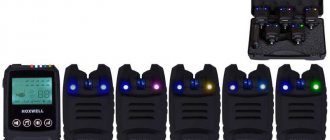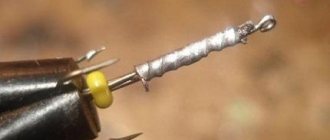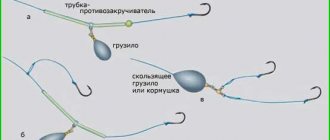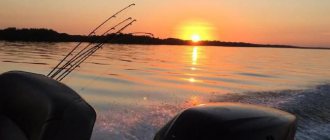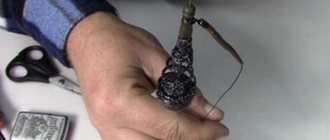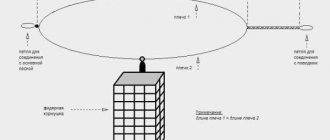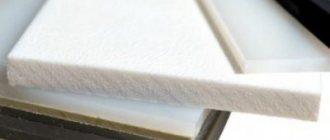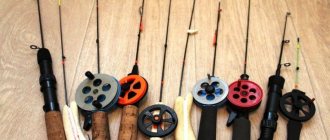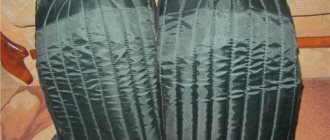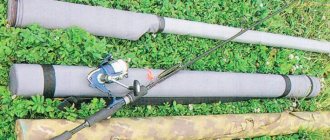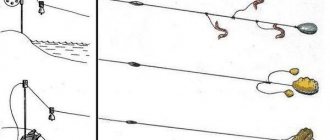Features of winter fishing on a lavsan guardhouse
Proper operation of the bite alarm can significantly affect the weight of the winter trophy. Gatehouses are made from different materials, but we will focus on one - lavsan. Inexpensive and easy to manufacture, this type of nod has proven itself in different conditions and when hunting different fish.
Properties of a bite alarm made of lavsan for winter fishing
- Allows you to carry out any wiring: both quiet and active.
- Clearly shows all bites.
- It has a simple, reliable design and convenient fastening.
- The weight of the guard should be insignificant in order to respond to the weakest bite.
- Serves for a long time without loss of quality.
- Combines minimum price with maximum quality.
Interesting! Only a high-quality lodge will provide you with the desired catch.
Modifications of lavsan nods for winter fishing
- The length of the guard is determined by the type of fishing and the type of fish being hunted. Wind and cutting speed are also important when choosing.
- The softness of the guard affects the angle of its bending and should be selected according to the fish, fishing depth, and weather.
- The width of the guard determines how much it will sway in the wind and how well the bites will be visible; here it is important to maintain balance.
- The color of the bite alarm should be selected so that it is clearly visible against the background of the hole and snow, usually red, orange or other bright shades.
Healthy! Don’t forget that there is no “ideal” lodge; it is selected according to weather conditions, type of fish, and weight of gear.
Different types of fishing require the selection of different guards
In winter, the fish are less active, so very often you need to “stimulate” them in order to get the desired catch. Playing with bait is an indicator of the fisherman's skill. In addition, it brings excitement and excitement to fishing.
For the rewinder
- A short and hard nod will allow for high-frequency play with a heavy bait.
- The long nod is designed for slow oscillations when fishing for bream and roach.
- A straight guard will bend evenly.
- Cone and double-cone bite alarms are more sensitive, but require precise adjustment to the weight.
For jig
- It is selected according to the weight of the jig: the softer the nod, the lighter the bait should be.
- Hardness is also determined by the speed of the current: soft ones are suitable for still water, heavy ones - for fishing at a depth of 5 meters.
- You can safely apply the principles of selecting a guard for a mothless moth.
For balancer
- Selected specifically for the weight of the balancer.
- Lavsan used is hard and thick.
Question about the need for a nod
There are two opposing opinions regarding whether a nod is needed when fishing with a balance beam. Some fishermen consider this element superfluous, in some cases even harmful for proper play, arguing that a well-chosen rod already gives back to the hand when biting.
However, most professionals still use the nod. This tackle greatly simplifies the ability to perceive the slightest bite and allows you to quickly respond to the situation.
Even with the ideal combination of rod and weight of the bait used, there is a high probability of missing a careful bite. When using a well-chosen nod, such a situation is practically excluded.
Flaws
The main disadvantage of using a guard when fishing with a balance beam is the unnecessary vibrations that interfere with proper fishing. But such vibrations are only possible if you use a too elastic nod that is not adjusted to the weight of the load.
According to some fishermen, the use of this element of equipment makes the fishing rod unnecessarily bulky and even clumsy when sharply hooked. However, usually these statements are subjective and based on personal negative experience, which does not always reflect the real situation. In reality, the nod is not capable of influencing hooking, and its small dimensions and weight do not greatly affect the overall weight of the fishing tool.
Advantages
The lack of high sensitivity of the fishing rod to weak bites is not so critical when catching pike, which actively grabs the bait and moves to the side with force. However, in the case of perch fishing, most bites will be more accurate. Perhaps an experienced angler with a well-chosen whip will be able to determine the bite without nodding. But a beginner in this situation may encounter difficulties. Especially when fishing in winter, when the predator is most careful.
Pike caught on a balance beam with a nod
A properly selected guard does not require the angler to constantly be in a state of tension in order to understand in time when the fish has caught the bait. It is enough just to look at the gatehouse and react to its movement.
Popular fishing models: Tula, sports, Salmo
Manufacturers offer a large selection of lavsan nods.
It is convenient for beginners (and not only) fishermen to use proprietary recommendations on the weight of jigs for specific types of bite alarms.
We can say a little about the most popular models of nods available on the market.
Trading company “Tula Mormyshka”
Offers three modifications: single nod, double nod and sports. At the same time, you can select several nod options for each jig. There is a catalog with a comparison of the size of the jig and the type of nods.
Sports
They are made significantly lighter; they lack rings and a washer at the end. From such models
cutting speed and efficiency are required.
There are many manufacturers of sports equipment on the market; they differ in the quality of materials and, accordingly, in the price of nods.
Company Salmo
It has proven itself well; its gatehouses are durable, versatile and resistant to wind loads.
Some models have the ability to adjust the working length.
Good elasticity allows you to customize the shape for specific tasks, including making an upward bend.
What is it - lavsan
Lavsan is a synthetic material made from petroleum products, one of the types of thermoplastic. Belongs to the group of polyester fibers. The chemical name of the fiber is polyethylene terephthalate.
Polyesters are high molecular weight compounds in which the molecules are joined in complex groups. Polyethylene terephthalate is the most commonly used of the polyesters. The molecules of the substance are rigid and have a highly elongated shape.
Dacron fibers look like threads with a smooth surface, round cross-section, and slight shine. The thickness of the thread depends on its purpose.
Characteristics of lavsan:
- Hygroscopicity. Low: Dacron is waterproof. It does not deform and does not change properties in water.
- Form stability. Lavsan does not shrink when exposed to high temperatures.
- Elasticity. Elasticity is high. The fibers stretch and then return to their original shape.
- Resistant to chemicals such as acid, organic solvents and alkalis.
- UV resistance. High.
- Strength. High: the fabric is resistant to tearing and physical impact.
- Thermal insulation properties. High: the material retains heat.
- Breathability. Low.
- Combustion reaction. A white flame and black soot are formed.
- Antibacterial properties. Mylar fibers do not have suitable conditions for the development of fungi and bacteria.
- Difficulty in coloring. Lavsan does not absorb dyes well. Therefore, it can be painted only with the help of chemicals.
Dacron fiber was first invented in 1935 in Great Britain. In Russia, the development of polyethylene terephthalate was carried out by the scientist Aizenstein at the Laboratory of Macromolecular Compounds of the USSR Academy of Sciences.
By the way, the material is called lavsan only in the CIS countries; in other countries it is known under the names dacron, tergal, terylene.
To obtain lavsan, oil is used, which is repeatedly processed in different ways. As a result, ethylene glycol is obtained and combined with terephthalic acid. The resulting polymers are melted and passed through special fillers (tiny holes).
The resulting fibers are so thin that they resemble a spider's web. When hot they stick together. This produces a thread that is wound onto a bobbin or used to weave fabrics. The thickness of the thread depends on the diameter of the fillers and the number of glued fibers.
Nylon and polyethylene terephthalate belong to the same group. You can distinguish lavsan from nylon by burning. The first material will produce black soot, while the other will produce an unpleasant odor without soot.
The cost of the simplest fabric options starts from 200 rubles per meter.
Watch educational program:
Types of fabric
Mylar fibers are used to produce fabrics. They come in the following types:
- Homogeneous. This material is exclusively made from lavsan. Such fabrics are used to make linings or outer layers of outerwear, umbrellas, decorative home textiles, etc.
- Cotton. A mixture of cotton and lavsan (the latter is present in smaller quantities). Thanks to this composition, the fabric does not shrink when washed, allows air to pass through, absorbs moisture, and is durable and strong. It is used for sewing casual, home clothes, bed linen.
- Woolen. Mylar fibers are also often added to woolen threads. This reduces the cost of the finished product, makes it more durable, and protects it from deformation when wet. The fabric is used for sewing suits.
- Viscose. The fabric, which combines lavsan synthetic fiber and semi-natural viscose, is pleasant to wear, soft to the touch, and durable. Used for sewing everyday clothes.
Making gear for winter fishing with your own hands. Where can I get the material?
Lavsan is a thermoplastic, it has many brand names. In everyday life, lavsan is found in various plastic products: these are disposable bottles, x-ray film, plastic packaging of devices, inserts in clothing. There is a special sheet of plastic for making covers and containers, trays for dishes. Lavsan for nods is also sold in fishing stores.
Healthy! When making a gatehouse with your own hands, its properties can only be determined through testing.
What do you need to watch out for when making a bite alarm with your own hands?
- A bait with a nod that is too hard will be too mobile.
- A nod that is too soft will not be able to convey movement to the bait.
When making a lavsan guardhouse with your own hands, first of all you need to determine the shape of the working part. There may be several options:
- conical (trapezoidal, “swallow wing”);
- biconical (i.e., having a conical shape in the planes of width and thickness);
- spring
If you decide to make a bite alarm yourself, you should focus on a design that is not on sale or that is suitable for a certain weight of the bait.
Especially if the store nods are too rough for fine work.
Reference! To make from Dacron you will need a piece of plastic, scissors or a utility knife, a ruler, a needle, sandpaper or a utility blade, a permanent marker or nail polish.
Manufacturing process
- Choose high-quality material; it should straighten out at the bends.
- Using a ruler, measure out an even strip 3.5 millimeters wide of the required length. Narrow the end to 1.5 millimeters.
- Cut the strip with scissors or a knife.
- Using a blunt needle, punch a hole for the fishing line.
- Make a holder from an insulating tube and secure the guard.
- Check the desired bend by hanging the jig.
- If necessary, grind off excess thickness with sandpaper or a razor blade. Constantly check the result by hanging the jig.
The spring guard has a more complex design: three plates of different lengths are superimposed on each other.
The manufacturing process of a spring bite alarm
- Choose high-quality plastic.
- Cut a strip of the required length with a cone; At the base along the edges there is a margin left for bending.
- Cut two more strips half and two-thirds the length of the main one.
- Place the strips on top of each other, folding the edges of the longest one, forming a holder.
- Using plastic tubes (for example, insulating tubes), fasten the strips together.
- Bend the working end of the guard, sand it with fine-grained sandpaper, and punch a hole for the fishing line.
- Secure the nod in the connector, which can also be made from a plastic tube.
Interesting! This bite alarm can be made without a long plate holder, and the three plates can be fastened together with tubes.
How to make a connector?
You can use insulating tubes, two-core wires, cambrics.
Tubes of different diameters are combined using universal waterproof glue (the main thing is that it does not change its properties in the cold), heat shrink or thread soaked in glue.
The line should be passed where the guard plate is inserted, or additional cambric can be glued. A two-core cable is convenient because it has two holes at once.
You can paint the finished nod with any permanent material: nail polish, permanent marker.
Nod for a sports fishing rod
In this post I’ll tell you a little about how I collect nods for winter fishing individually for each jig. I came to something myself and they suggested something. In general, you need some minimal set of hand tools and a little time. In general, making a nod is akin to meditation. You can, of course, rivet a hundred in an evening, but you can also fuss with just one - for example, I need a certain mood and so that nothing distracts me. The most difficult thing in this process is probably finding a suitable material for the nod and its fastening. A variety of films will do - lavsan is of course the most suitable - you can look in printing houses, you can buy a drum membrane at a musical instrument store - they are also made from lavsan, film will do from floppy disks, protective film for phone screens, astrolon - can be found in keyboards, even film for x-rays is suitable. I made from all of the above - but settled on three main materials - astrolon, lavsan and floppy disk film.
for manufacturing we will need the following tools: a knife for precision work or the blade of a stationery knife, a ruler, a 2 mm drill, a syringe needle, a hand drill - can be found in medical equipment and fishing stores, a Dremel bur, a lighter, sandpaper of various grain sizes and permanent markers black and red
and materials: lavsan, thermofit, thick silicone cambric and pvc cambric
Almost all the necessary components are collected in one box.
Using a ruler and a knife, cut off the blanks for the nod
Using a syringe needle, we make a small puncture in the center at the tip of the nod - so that the hook of the jig clings and can hang.
Next comes the most important point - using sandpaper, we begin to bring the thickness of our workpiece to the optimal angle of loading our nod specifically for the jig - we set the taper of the nod - it is thicker at the base/mount and thinner at the end. This operation can be done using a knife blade - as if scraping off excess material, or you can also use sandpaper.
A few movements and hang the jig while watching the corner
We sharpened it and checked it again with a jig
and so on until you don’t like the bend or weight of the nod - because some people prefer overloaded nods, and some prefer underloaded nods.
So we’ve decided on the load, now let’s work on the holes for the fishing line. We have a puncture from the needle, it needs to be expanded - you can do this with the same needle - but here you need a certain skill to maintain the centering of the hole, and this can be done in several stages. First, take a drill and expand the hole with it.
then, using a Dremel bur or drill, we adjust the diameter of the hole to the required one.
You need to try to ensure that the thickness of the material around the hole is the same and sufficient - otherwise during fishing it may tear and the nod will become unusable. You can, of course, make a special platform for this hole - but this complicates the entire manufacturing process a little
We carry out the same operations with the second hole for passing the fishing line, but it should be slightly smaller - for the strength of the section
Now you need to countersink the holes a little using our 2 mm drill, just make a few turns without pressing on all sides, just remove the sharp edges from the drilling - so that the thin line does not injure itself and does not injure the nod.
Now to the paint shop. here, who already has enough imagination for something - I paint with permanent markers
Now let's move on to attaching the nod. To do this, take a regular pencil sharpener and a silicone cambric and make a cone
cut off the required amount of material from thermofit and PVC cambric
We put the silicone cambric on a toothpick and collect our components and take a lighter and warm up the thermofit little by little
the output is the following montage
All that remains is to squeeze the lavsan nod between the thermofit and the silicone cambric and the product is ready. It is important that the lavsan sits tightly in the holder - if necessary, the thermofit can be heated again with a lighter. This is the nod we got
in the transport position it hangs on the fishing line and the jig is stuck into the rubber nipple so that the fishing line comes out of it without fractures
I talked a lot about materials and techniques about what I use in most cases using easily accessible materials and components. That's basically it. Thank you for your attention!
Post edited by Artyom Zakharov: 09 February 2021 — 12:03
How to set it up for a jig?
When using a nod purchased in a store, you should follow the manufacturer's recommendations for the size of the jig. If you made the tackle yourself, you need to select the jig experimentally.
Healthy! When adjusting without immersion in water, the guard should bend by 20–30 degrees. The upturned end should bend about 10 degrees.
The size of the jig is selected according to the fish that will be hunted, and taking into account the characteristics of the reservoir. The fishing line is also selected. Accordingly, based on this, you need to choose a suitable nod.
Reference! In strong winds, it is better to overload the tackle, because due to its weak weight, it will sway from any blow and show false bites.
- Choose the right combination of jig size and line thickness. For example, if you are fishing with a 2.5–4 mm jig, choose a 0.12 mm line.
- You can prepare several fishing rods for different depths with different size baits.
- When immersed in water, the best angle of bending of the equipment is considered to be 45 degrees.
- If necessary, the bite alarm can be sanded on site to the required thickness.
Nod for balancer
There are still disagreements between fishermen about the advisability of installing a nod when fishing with a balance beam. Some confidently insist that the nod for fishing with a balancer is almost the most important, since in winter bites on a balancer are no less careful than with a jig. And without a nod, such a bite cannot be recognized. Such fishermen advise installing hard nods from various materials: a twisted spring, a thick Mylar film, a clock spring, a nipple or a silicone tube in bright colors. Which nod is better for a balancer, you ask? The main thing is that it is matched to the weight of the balancer. This is easy to determine. If your nod for fishing with a balancer is chosen correctly, then it should clearly show the moment of the bite, record the moment when the balancer reaches the bottom and “gets hooked.”
Opponents of this theory claim that using a balance beam for winter fishing is a waste of effort and money. In their opinion, during a serious bite, when you hit a schooling perch or pike perch, there is no need for a sensitive nod. And modern materials from which whips are made are very sensitive and allow you to recognize most bites. If a fisherman correctly selects the stretchability of the fishing line to the weight of the bait, then it is very difficult not to notice the bite, and if he fishes literally “with his finger,” then it is impossible not to notice the bite at all. Therefore, whether you use a nod when fishing with a balancer or not is up to you to decide. There is no consensus on this matter.
Which type of game is more catchy?
The amplitude of the game is influenced by the length of the guard: the longer, the calmer. At the same time, different types of fish react to different games.
- White fish (roach, bream, silver bream) need to be caught with a smooth action, which means using a long guard.
- For perch, ruffe, bleak, small roach, a high-frequency game is needed, “trembling” - a shorter nod is taken.
- Using experience, you can choose a universal guard for different types of fish.
Reference! The softer the nod, the better it shows careful bites and the easier it is for them to create high-frequency action.
Which material is better for winter fishing: lavsan or metal?
You can use different materials for lodges; the choice depends on the personal preferences of the fisherman, the type of fish and the weather.
Each has its own positive and negative properties. Let's compare metal and lavsan bite alarms for winter fishing.
Lavsan
Pros:
- temperature resistance;
- low cost, ease of manufacture and modification on site;
- sensitivity to subtle play and careful bites.
Minuses:
- passive fish may not react to the leash;
- High frequency playing requires skill and effort.
Metal
Pros:
- ability to use heavy equipment;
- stability in the wind.
Minuses:
- difficulty in manufacturing;
- susceptibility to corrosion;
- Stainless steel is expensive;
- Less sensitivity in the game.
Nod to the rewinder
We turned to a fishing store specialist and learned how to choose the right nod for a reelless reel. According to most experts in this matter, when fishing with a baitless jig, at shallow depths and weak currents, a Mylar nod will be ideal. The water is calm, which means you don’t have to use large baits, choosing miniature jigs. Therefore, in this case, a lavsan nod will be indispensable, since it is able to provide the desired result in the game with a no-attachment jig.
But if you fish at great depths, or in places with a noticeable current, then it is better to use heavy jigs, and therefore a nod that is less sensitive to loads, which can hardly be called lavsan.
Useful video
Watch an interesting video on how to make a nod with your own hands, even for a beginner:
Selecting a lodge for winter fishing is an important task that requires an accurate determination of the fisherman’s goals and weather conditions. To work with heavy baits, you can choose a metal version, but lavsan ones provide more opportunities for varied play.
Lavsan alarms are easy to make yourself, they are easy to use and durable. Our recommendations will help you choose the perfect nod for the best catch.
